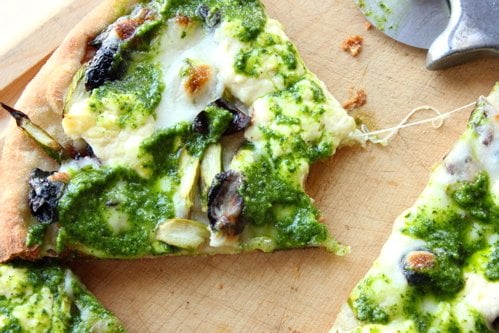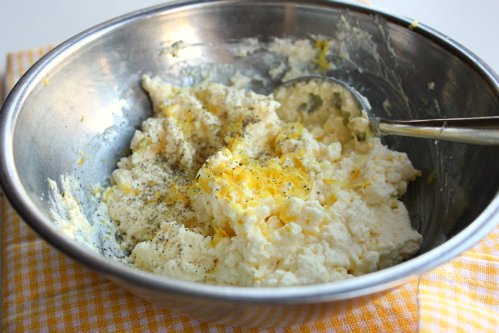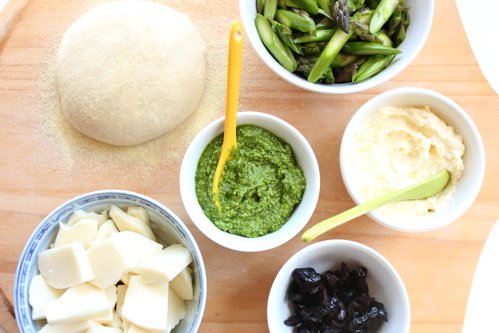Asparagus Pesto Pizza (original) (raw)

If New York City is the twenty-something party-goer that never sleeps, then San Francisco is its geriatric grandparent that sacks out as soon as the sun goes down.Late-night eateries are few and far between, and you're lucky to find a restaurant that will seat you after 8:45 pm.

When Jay and I found ourselves peckish at 9 o'clock on a balmy night last week, we decided to treat ourselves to a meal at Flour+Water, a local pizzeria rife with indecipherable menu items, minimalist decor, and indy rock that serves thin-crust pizza, hand-made pasta and heavenly desserts until midnight. A pie costs a whopping $16 minimum, but their killer on-tap beer (and wine- yes, on tap!) selections make it possible to wash down the annoying atmosphere.

Sadly, when we arrived at Flour+Water, long after most SF restaurants have closed, we found it packed full of fellow "late"-night diners spilling out onto the sidewalk awaiting their over-priced bread-and-cheese dinners.
Someone needs competition.
"You make better pizza than they do, anyway," Jay declared loyally, as we turned on our heels and headed to El Metate, which is open until 10, for a veggie taco plate and brown-bagged Anchor Steams from a nearby liquor store.

But I still had a craving for pizza. So inspired by the "bianco verde" pizza on the menu at Flour+Water of which I was deprived, I whipped up this pie the next day.
I used some kamut flour in the dough, which gave it a pretty, golden hue and wheaty depth of flavor. I pureed up a (triple) batch of our favorite pesto (so we'd have enough left over to smear on sandwiches, pasta, and eggs for days), sliced up some asparagus stalks and mozzarella, mixed luscious whole-milk ricotta with lemon zest and pepper, and chopped up briny, oil-cured olives.

I baked the dough first with just the asparagus in order to give the crust a chance to crisp and puff and to roast and concentrate the flavor of the asparagus. I then added the olives and cheeses baked the pie until all was golden and gooey. Then, inspired by a pizza Jay and I once shared at Pauline's, Flour+Water's older and less-pretentious cousin in the Mission, painted on the pesto after the fact, so that it remained vibrant.

Fresh pizza is like chocolate chip cookies in that most any pie straight from the oven is the best pizza ever, and this was no exception. The crisp crust supports gooey cheese, grassy asparagus, tangy lemon, sweet ricotta, piquant olives and herbaceous pesto: springtime on a crunchy crust.

Our mouths are happy, and so are our wallets. And best of all, we have the makings for two more pizzas just like it. If you make this pizza, I dare say you will be happy, too.

But if you'd rather go to Flour+Water, take my advice: make like a grandma and get there at 5pm.

More Pizza Recipes:
- Roasted Eggplant and Fontina Pizza
- Sourdough Pizza with Chanterelles, Shallots and Chèvre
- Herbed Spinach and Goat Cheese Calzone
- Padrón Pepper Margherita Pizza {gluten-free}
*Bojon appétit! For more Bojon Gourmet in your life, follow along on Instagram, Facebook, or Pinterest, purchase my gluten-free cookbook Alternative Baker, or subscribe to receive new posts via email. And if you make this asparagus pesto recipe, I’d love to know. Leave a comment and rating below, and tag your Instagram snaps @The_Bojon_Gourmet and #bojongourmet.*

Asparagus Pesto Pizza with Oil-Cured Olives and Lemon Ricotta
A delicious homemade pizza perfect for Spring.
Prep Time: 30 minutes
Cook Time: 10 minutes
Resting time: 1 hour
Total: 1 hour 40 minutes
Servings: 9 servings (makes three 12" pizzas, about 3 servings per pizza).
The dough:
- 1 package active dry yeast (about 2 1/4 teaspoons)
- 1 1/2 cups warm water
- 2 tablespoons extra-virgin olive oil
- 1 1/2 teaspoons sea salt
- 1/2 cup kamut flour (or whole wheat bread flour)
- 2 1/2 to 3 cups "type 00" pizzeria flour (or white bread flour)
The Pesto:
- 2 cups packed fresh basil leaves
- 3 tablespoons pine nuts
- 2 cloves garlic
- 1/3-1/2 cup olive oil
- 1/2 cup freshly grated parmesan cheese
- about 1/4 teaspoon fine sea salt (to taste)
The toppings:
- 12-16 ounces whole milk ricotta (I like Bellweather Farms' basket-dipped)
- zest of 1 lemon
- sea salt and freshly ground pepper
- 1 generous pound asparagus stalks, sliced thinly on a steep diagonal, heads kept in tact
- olive oil
- 1 pound dry mozzarella, sliced
- 12-16 whole oil-cured olives, pitted and coarsely chopped
Cook ModePrevent your screen from going dark
Make the dough:
- Place the water in the bowl of a stand mixer, and sprinkle the yeast over the top. Let sit 5-10 minutes to dissolve, then add the oil, salt, kamut flour, and 1 1/2 cups of the 00 flour. Fit the mixer with the dough hook, and mix on low speed for 5 minutes to make a wet dough, scraping down the sides of the bowl as necessary. Add 1 more cup of 00 flour. Increase the mixer speed to medium, and knead for 7 minutes, adding more flour by the tablespoon until dough comes away from the sides of the bowl. After 7 minutes, the dough should feel smooth and soft, and slightly sticky, but not too wet.
- Place the dough in a large, lightly oiled bowl or container, and cover tightly with plastic wrap or a lid. Let the dough rise in a warm place until doubled or tripled in bulk, 1 to 1 1/2 hours.
Make the pesto:
- While you stem the basil, bring a medium saucepan filled two-thirds full with water to a rolling boil. Fill a medium bowl with ice and cool water. Blanch the basil in the boiling water for 10 seconds, until wilted and bright green, then plunge into the ice bath. When cool, squeeze the dickens out of the basil to remove the water. (Alternately, leave the basil fresh if you plan to use up all the pesto within a day or two.)
- Place the basil (blanched or noin a food processor with the pine nuts, garlic and cheese. Puree until fairly smooth, adding some of the olive oil if you need to help the mixture blend. With the motor running, drizzle in the olive oil until the mixture reached the consistency of a thick paste, then season to taste with the salt.
- If storing the pesto, place it in a jar and cover with a thin layer of olive oil (this will help prevent it from oxidizinand place in the fridge for up to a week or two, or in the freezer for up to several months.
Assemble and bake the pizzas:
- Position a rack in the bottom of the oven, and remove any other racks from the oven. If you have a baking stone, place it on the rack. (Lacking a stone, form the pizza directly onto a parchment-lined sheet pan in the following steps.) Preheat the oven to 500º for at least 30 minutes.
- In a medium bowl, stir together the ricotta and lemon zest; season to taste with salt and pepper.
- In another medium bowl, toss the sliced asparagus with a bit of olive oil to coat and a pinch of salt.
- Divide the dough into three balls, and keep the other two covered while you work with the first. On a lightly floured surface, tuck the edges of the dough under itself to make a loose ball, then flatten the dough into a disc. Gently press, pull and stretch the dough into a 12" round; if it is very springy, let it rest for a few minutes to relax the glutens. Try not to tear the dough. I like to make my hands into fists, drape the dough round over my knuckles, and let gravity stretch it.
- Place the dough on a piece of parchment paper set on a pizza peel (or large cutting board). Trim the edges of the parchment so they stick out 1" on all sides. Spread 1/3 of the asparagus evenly over the dough. Slip the dough, parchment and all, onto the heated stone and bake until dry and the asparagus is beginning to wilt and turn golden around the edges, 3-5 minutes.
- Use a pair of tongs to pull the pizza and parchment out of the oven and onto the peel. Scatter 1/3 of the olives over the asparagus, lay 1/3 of the mozzarella over the top, and dollop 1/3 of the ricotta in the gaps in teaspoon-sized lumps.
- Return the pizza to the oven, without the parchment this time, and bake until the cheese is melted and the sides and bottom of the crust are golden brown, 4-5 more minutes. Remove from the oven and place on a large cutting board. Gently smear a thin layer of pesto over the top of the pizza using the back of a spoon.
- Cut the pizza into 6-8 wedges and serve.
- Repeat with the remaining 2 pizzas.
The dough is adapted from The Cheese Board Collective Works.
This recipe makes three large-ish pizzas; extra dough can be stored in an oiled, air-tight container (that is a few times the size of the dough to allow for expansion) in the fridge for up to 5 days, or in the freezer for up to 1 month. The dough actually benefits from resting for 1-3 days in the fridge, becoming more flavorful, and baking up even more crisp and light. Bring the dough to room temperature before proceeding with the recipe. Since pizza dough is generally fairly wet, it is best kneaded in a stand mixer fitted with the paddle attachment. If you must knead it by hand, add as little flour as possible to keep the dough from sticking to your hands and the kneading surface.
The pesto recipe may make more than you will need for the three pizzas, depending on how much of a pesto hog you are. (I made a triple batch of the recipe, since we like to put pesto on everything from cheesy toast to polenta to bean soups to lasagna.)
I like the oil-cured olives for their piquancy, but their strong flavor makes it necessary to chop them fairly finely. Some of the photos above are from my first trial, in which I halved the olives, but I found the flavor too strong this way. Finely chopped and in moderation, the olives add a perfectly-balanced oomph.
Nutritional values are based on one of nine servings.
Calories: 699kcalCarbohydrates: 66gProtein: 30gFat: 35gSaturated Fat: 13gCholesterol: 64mgSodium: 974mgPotassium: 314mgFiber: 4gSugar: 2gVitamin A: 1240IUVitamin C: 4.9mgCalcium: 433mgIron: 2.7mg
Asparagus Pesto Pizza with Oil-Cured Olives and Lemon Ricotta
This recipe makes three large-ish pizzas; extra dough can be stored in an oiled, air-tight container (that is a few times the size of the dough to allow for expansion) in the fridge for up to 5 days, or in the freezer for up to 1 month. The dough actually benefits from resting for 1-3 days in the fridge, becoming more flavorful, and baking up even more crisp and light. Bring the dough to room temperature before proceeding with the recipe. Since pizza dough is generally fairly wet, it is best kneaded in a stand mixer fitted with the paddle attachment. If you must knead it by hand, add as little flour as possible to keep the dough from sticking to your hands and the kneading surface.
The pesto recipe may make more than you will need for the three pizzas, depending on how much of a pesto hog you are. (I made a triple batch of the following recipe, since we like to put pesto on everything from cheesy toast to polenta to bean soups to lasagna.)
I like the oil-cured olives for their piquancy, but their strong flavor makes it necessary to chop them fairly finely. Some of the photos above are from my first trial, in which I halved the olives, but I found the flavor too strong this way. Finely chopped and in moderation, the olives add a perfectly-balanced oomph.
Makes three 12" pizzas, about 3 servings per pizza
The dough:
Adapted fromThe Cheese Board Collective Works
1 package (about 2 1/4 teaspoons) active dry yeast
1 1/2 cups warm water
2 tablespoons extra-virgin olive oil
1 1/2 teaspoons sea salt
1/2 cup kamut flour (or whole wheat bread flour)
2 1/2 to 3 cups "type 00" pizzeria flour (or white bread flour)
The Pesto:
2 cups packed fresh basil leaves
3 tablespoons pine nuts
2 cloves garlic
1/3-1/2 cup olive oil
1/2 cup freshly grated parmesan cheese
about 1/4 teaspoon fine sea salt (to taste)
The toppings:
12-16 ounces whole milk ricotta (I like Bellweather Farms' basket-dipped)
zest of 1 lemon
sea salt and freshly ground pepper
1 generous pound asparagus stalks, sliced thinly on a steep diagonal, heads kept in tact
olive oil
1 pound dry mozzarella, sliced
12-16 whole oil-cured olives, pitted and coarsely chopped
Make the dough:
Place the water in the bowl of a stand mixer, and sprinkle the yeast over the top. Let sit 5-10 minutes to dissolve, then add the oil, salt, kamut flour, and 1 1/2 cups of the 00 flour. Fit the mixer with the dough hook, and mix on low speed for 5 minutes to make a wet dough, scraping down the sides of the bowl as necessary. Add 1 more cup of 00 flour. Increase the mixer speed to medium, and knead for 7 minutes, adding more flour by the tablespoon until dough comes away from the sides of the bowl. After 7 minutes, the dough should feel smooth and soft, and slightly sticky, but not too wet.
Place the dough in a large, lightly oiled bowl or container, and cover tightly with plastic wrap or a lid. Let the dough rise in a warm place until doubled or tripled in bulk, 1 to 1 1/2 hours.
Make the pesto:
While you stem the basil, bring a medium saucepan filled two-thirds full with water to a rolling boil. Fill a medium bowl with ice and cool water. Blanch the basil in the boiling water for 10 seconds, until wilted and bright green, then plunge into the ice bath. When cool, squeeze the dickens out of the basil to remove the water. (Alternately, leave the basil fresh if you plan to use up all the pesto within a day or two.)
Place the basil (blanched or not) in a food processor with the pine nuts, garlic and cheese. Puree until fairly smooth, adding some of the olive oil if you need to help the mixture blend. With the motor running, drizzle in the olive oil until the mixture reached the consistency of a thick paste, then season to taste with the salt.
If storing the pesto, place it in a jar and cover with a thin layer of olive oil (this will help prevent it from oxidizing) and place in the fridge for up to a week or two, or in the freezer for up to several months.
Assemble and bake the pizzas:
Position a rack in the bottom of the oven, and remove any other racks from the oven. If you have a baking stone, place it on the rack. (Lacking a stone, form the pizza directly onto a parchment-lined sheet pan in the following steps.) Preheat the oven to 500º for at least 30 minutes.
In a medium bowl, stir together the ricotta and lemon zest; season to taste with salt and pepper.
In another medium bowl, toss the sliced asparagus with a bit of olive oil to coat and a pinch of salt.
Divide the dough into three balls, and keep the other two covered while you work with the first. On a lightly floured surface, tuck the edges of the dough under itself to make a loose ball, then flatten the dough into a disc. Gently press, pull and stretch the dough into a 12" round; if it is very springy, let it rest for a few minutes to relax the glutens. Try not to tear the dough. I like to make my hands into fists, drape the dough round over my knuckles, and let gravity stretch it.
Place the dough on a piece of parchment paper set on a pizza peel (or large cutting board). Trim the edges of the parchment so they stick out 1" on all sides. Spread 1/3 of the asparagus evenly over the dough. Slip the dough, parchment and all, onto the heated stone and bake until dry and the asparagus is beginning to wilt and turn golden around the edges, 3-5 minutes.
Use a pair of tongs to pull the pizza and parchment out of the oven and onto the peel. Scatter 1/3 of the olives over the asparagus, lay 1/3 of the mozzarella over the top, and dollop 1/3 of the ricotta in the gaps in teaspoon-sized lumps.
Return the pizza to the oven, without the parchment this time, and bake until the cheese is melted and the sides and bottom of the crust are golden brown, 4-5 more minutes. Remove from the oven and place on a large cutting board. Gently smear a thin layer of pesto over the top of the pizza using the back of a spoon.
Cut the pizza into 6-8 wedges and serve.
Repeat with the remaining 2 pizzas.
